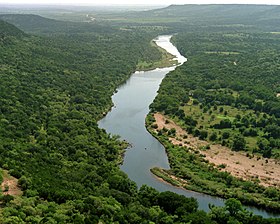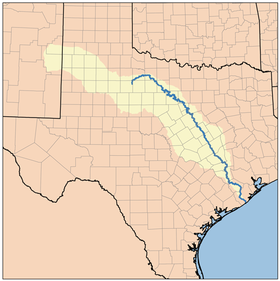Brazos River
| Brazos River Río de los Brazos de Dios | |
|---|---|
 Brazos River downstream of Possum Kingdom Lake, Palo Pinto County, Texas | |
 Brazos River watershed | |
| Location | |
| Country | United States |
| State | Texas |
| Physical characteristics | |
| Source | Llano Estacado |
| Source confluence | Stonewall County, Texas |
| • coordinates | 33°16′07″N 100°0′37″W / 33.26861°N 100.01028°W[1] |
| • elevation | 453 m (1,486 ft) |
| Mouth | Gulf of Mexico |
• location | Brazosport, Brazoria County, Texas |
• coordinates | 28°52′33″N 95°22′42″W / 28.87583°N 95.37833°W[1] |
• elevation | 0 m (0 ft) |
| Length | 1,352 km (840 mi) |
| Basin size | 116,000 km2 (45,000 sq mi) |
| Discharge | |
| • location | Freeport, Texas |
| • average | 237.5 m3/s (8,390 cu ft/s) |
| • minimum | 0.76 m3/s (27 cu ft/s) |
| • maximum | 2,390 m3/s (84,000 cu ft/s) |
The Brazos River (/ˈbræzəs/ BRAZ-əs, Spanish: [ˈbɾasos]), called the Río de los Brazos de Dios (translated as "The River of the Arms of God") by early Spanish explorers, is the 14th-longest river in the United States at 1,280 miles (2,060 km) from its headwater source at the head of Blackwater Draw, Roosevelt County, New Mexico[2] to its mouth at the Gulf of Mexico with a 45,000-square-mile (116,000 km2) drainage basin.[3] Being one of the largest rivers in Texas,[4] it is sometimes used to mark the boundary between East Texas and West Texas.
The river is closely associated with Texas history, particularly the Austin settlement and Texas Revolution eras. Today major Texas institutions such as Texas Tech University, Baylor University, and Texas A&M University are located close to the river's basin, as are parts of metropolitan Houston.
Geography
[edit]The Brazos proper begins at the confluence of the Salt Fork and Double Mountain Fork, two tributaries of the Upper Brazos that rise on the high plains of the Llano Estacado, flowing 840 miles (1,350 km) southeast through the center of Texas. Another major tributary of the Upper Brazos is the Clear Fork Brazos River, which passes by Abilene and joins the main river near Graham. Important tributaries of the Lower Brazos include the Paluxy River, the Bosque River, the Little River, Yegua Creek, the Nolan River, the Leon River, the San Gabriel River, the Lampasas River, and the Navasota River.[5]
Initially running east towards Dallas-Fort Worth, the Brazos turns south, passing through Waco and the Baylor University campus, further south to near Calvert, Texas, then past Bryan and College Station, then through Richmond, Texas, in Fort Bend County, and empties into the Gulf of Mexico in the marshes just south of Freeport.[3]
The main stem of the Brazos is dammed in three places, all north of Waco, forming Possum Kingdom Lake, Lake Granbury, and Lake Whitney. Of these three, Granbury was the last to be completed, in 1969. When its construction was proposed in the mid-1950s, John Graves wrote the book Goodbye to a River. The Whitney Dam, located on the upper Brazos, provides hydroelectric power, flood control, and irrigation to enable efficient cotton growth in the river valley.[4] A small municipal dam (Lake Brazos Dam) is near the downstream city limit of Waco at the end of the Baylor campus; it raises the level of the river through the city to form a town lake. This impoundment of the Brazos through Waco is locally called Lake Brazos. Nineteen major reservoirs are located along the Brazos.[6]
-
North Fork Double Mountain Fork Brazos River at the edge of the Llano Estacado
-
Double Mountain Fork Brazos River at the site of former Rath City, Texas
-
The Brazos in north Central Texas
-
The Brazos in southeast Central Texas west of Bryan, Texas
History
[edit]
In 1822, the lower river valley of the Brazos River became one of the major Anglo-American settlement sites in Texas. This was one of the first English-speaking colonies along the Brazos and was founded by Stephen F. Austin at San Felipe de Austin.[4] In 1836, Texas declared independence from Mexico at Washington-on-the-Brazos, a settlement in now Washington County that is known as "the birthplace of Texas".[7] Brazos River was also the scene of a battle between the Texas Navy and Mexican Navy during the Texas Revolution. Texas Navy ship Independence was defeated by one Mexican vessel.
When it was first named by European explorers is unclear, since it was often confused with the Colorado River not far to the south, but it was certainly seen by René-Robert Cavelier, Sieur de La Salle. Later Spanish accounts call it Los Brazos de Dios (the arms of God), for which name several different explanations were given, all involving it being the first water to be found by desperately thirsty parties. In 1842, Indian commissioner of Texas, Ethan Stroud established a trading post on this river.
The river was important for navigation before and after the American Civil War, and steamboats sailed as far up the river as Washington-on-the-Brazos.[8] While attempts to improve commercial navigation on the river continued, railroads proved more reliable. The Brazos River also flooded, often seriously, on a regular basis before a piecemeal levee system was replaced, notably in 1913 when a massive flood affected the course of the river. The river is primarily important today as a source of water for power, irrigation, and recreation. The water is administered by the Brazos River Authority.[5]
The 2000 book, Sandbars and Sternwheelers: Steam Navigation on the Brazos by Pamela A. Puryear and Nath Winfield, Jr., with introduction by J. Milton Nance, examines the early vessels that attempted to navigate the Brazos.[9]
On June 2, 2016, the rising of the river required evacuations for portions of Brazoria County.[10]
Watershed
[edit]The Brazos River watershed covers a total area of 46,013 sq mi (119,174 km2).[11] Within the watershed lie 42 lakes and rivers, which have a combined storage capacity of 2.5 million acre-feet.[12] The Brazos watershed also has an estimated groundwater availability of 119,275 acre-feet per year.[13] Around 31% of the land use within the watershed is cropland, and roughly 61% is grassland (30%), shrubland (19.8%), and forest (11%), while urban use only makes up 4.6%. The population density within the watershed is 50.5 people/sq mi (19.5/km2).[11]
Water quality concerns
[edit]The main water-quality issues within the Brazos watershed are high nutrient loads, high bacterial and salinity levels, and low dissolved oxygen. These issues can be attributed to livestock waste, fertilizer, and chemical run offs. Sources of run off are croplands, pastures, and industrial sites, among others.[14] The watershed receiving the most toxic pollution is the lower Brazos river, which received 33.4 million pounds of toxic waste in 2012.[15]
Recreation
[edit]Canoeing is a very popular recreational activity on the Brazos River, with many locations favorable for launching and recovery. The best paddling can be found immediately below Possum Kingdom Lake and Lake Granbury.[16]
Sandbar camping is also permitted, since the entire streambed of the river is considered to be state-owned public property. Fishing, camping, and picnicking are legal here, including on the sandbars.[17] The river and its three lakes are popular spots for avid anglers and boat enthusiasts due to the diverse ecosystems in the water and convenient marinas nearby such as The Cliffs Marina.
Several scout camps are located along the Brazos River, and they support a wide range of water and shoreline activities for scouts, youth groups, and family groups.[18]
The Brazos River Authority maintains several public campsites along the river and at the lakes. Hunting is also permitted at select locations along the river. Fishing is permitted on all of the river, subject to regulations. Outdoor enthusiasts have the opportunity to view the area's scenery and the wildlife on the river.[citation needed] Fly fishing and river fishing for largemouth bass are common.[19]
See also
[edit]- Battle of the Brazos
- Blanco Canyon
- Brazoria, Texas
- Brazos Belle
- Brazosport Independent School District
- Canyon Valley, Texas
- Double Mountains (Texas)
- Double Mountain Fork Brazos River
- List of rivers of Texas
- List of longest rivers of the United States (by main stem)
- Mount Blanco
- North Fork Double Mountain Fork Brazos River
- USS Brazos (AO-4), a fleet oiler built in 1919
- White River (Texas)
- Yellow House Canyon
- Port Freeport
Footnotes
[edit]- ^ a b "Brazos River". Geographic Names Information System. United States Geological Survey, United States Department of the Interior.
- ^ Kammerer, J.C. (1987). "Largest Rivers in the United States". United States Geological Survey. Retrieved 2006-07-15.
- ^ a b Hendrickson Kenneth E. Jr. (1999-02-15). "Brazos River". The Handbook of Texas Online. The General Libraries at the University of Texas at Austin and the Texas State Historical Association. Archived from the original on July 10, 2011. Retrieved 2006-07-22.
- ^ a b c "Brazos River." Britannica Academic, Encyclopædia Britannica, 11 Aug. 2018. academic.eb.com/levels/collegiate/article/Brazos-River/16291. Accessed 27 Nov. 2018.
- ^ a b Hendrickson, Jr., Kenneth E. (1981). The Waters of the Brazos: A History of the Brazos River Authority 1929-1979. Waco, TX: The Texian Press.
- ^ "River Basin Map of Texas". Bureau of Economic Geology, University of Texas at Austin. 1996. Archived from the original (JPEG) on 2011-10-19. Retrieved 2006-07-15.
- ^ “Washington-on-the-Brazos State Historic Site.” Texas Parks and Wildlife, 6 Nov. 2018, tpwd.texas.gov/state-parks/washington-on-the-brazos.
- ^ "BRAZOS RIVER". tshaonline.org. 12 June 2010.
- ^ Sandbars and Sternwheelers: Steam Navigation on the Brazos. Texas A&M University Press. 2000. ISBN 1-58544-058-2.
- ^ Foxhall, Emily (2 June 2016). "Mandatory evacuations ordered in Brazoria County - Houston Chronicle". Chron.com. Retrieved 2016-06-04.
- ^ a b "USGS EDNA-Derived Watershed Characteristics". edna.usgs.gov. Retrieved 2016-10-12.
- ^ "River Basins - Brazos River Basin | Texas Water Development Board". www.twdb.texas.gov. Retrieved 2016-10-12.
- ^ "Brazos Valley Groundwater Conservation District". Brazos Valley Groundwater Conservation District. Retrieved 2016-10-12.
- ^ "The Brazos River Authority > About Us > Water Quality > Watershed Protection Plans > Leon River WPP". www.brazos.org. Retrieved 2016-10-12.
- ^ "Southern waters imperiled by toxic pollution". Facing South. 2014-06-23. Retrieved 2016-10-12.
- ^ "Brazos River & Paddling Trails - Parks & Recreation - City of Waco, Texas". Waco-texas.com. Retrieved 2016-06-04.
- ^ "The Brazos River Authority > About Us > Education > Water School". Brazos.org. Retrieved 2016-06-04.
- ^ "Texas Scout Camps". Maintour.com. 2013-11-26. Retrieved 2016-06-04.
- ^ "Home". Brazosriverfishing.com. Retrieved 2016-06-04.
Further reading
[edit]- Archer, Kenna Lang, “A Defiant River, A Technocratic Ideal: Big Dams and Even Bigger Hopes along the Brazos River, 1929–1958,” East Texas Historical Journal, 53 (Fall 2015), 67–87.
- Archer, Kenna Lang. Unruly Waters: A Social and Environmental History of the Brazos River. Albuquerque, NM: University of New Mexico Press, 2015.
- Hendrickson, Jr., Kenneth E. The Waters of the Brazos: A History of the Brazos River Authority 1929-1979. Waco, TX: The Texian Press, 1981.
- Kimmel, Jim. 2011. Exploring the Brazos River: from beginning to end. Texas A&M Press. College Station, TX.
External links
[edit]- Brazos River from the Handbook of Texas Online
- U.S. Geological Survey Geographic Names Information System: Brazos River
- Brazos River Authority
- Public domain photos of the Upper Brazos
- Historic photos of Army Corps of Engineers lock and dam projects on the Brazos River, 1910-20s, from the Portal to Texas History
- 1858 map titled Preliminary chart of entrance to Brazos River, Texas from a trigonometrical survey under the direction of A. Bache ; triangulation by J.S. Williams ; topography by J.M. Wampler ; hydrography by the parties under the command of E.J. De Haven & J.K. Duer., hosted by the Portal to Texas History.







